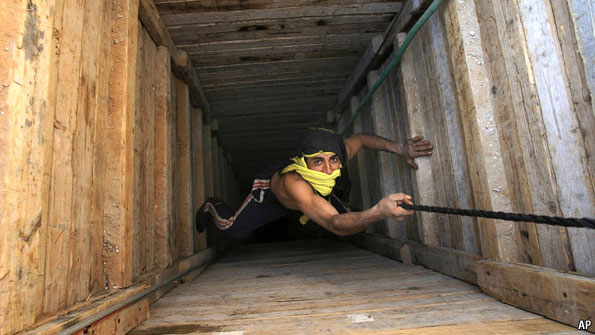The Gaza Strip
Hamas hangs on
Hamas has done well to survive but it is threatened by rivalry among Islamists
Mar 31st 2010 | GAZA | From The Economist print edition

AFTER four gruelling years under siege, the Gazans—and the Islamist movement, Hamas, that governs them—are still managing against the odds to survive. Some even prosper. The tunnels that snake under Gaza’s border with Egypt have multiplied so fast that supply sometimes exceeds demand. So stiff is commercial competition that tunnel-diggers complain that their work is no longer profitable. As a British parliamentary report recently noted, Israel officially allows Gaza to import only 73 of more than 4,000 items that are available in the strip. The rest is home-made—or acquired illicitly. For instance, cement, which cost 300 Israeli shekels ($80) a sack two years ago, has dropped almost tenfold in price, precipitating a spate of building for the first time since Israel’s attack a year ago reduced 4,000 houses to ruins. And eyewitnesses say that flashy 4x4 vehicles can actually drive through tunnels built from shipping containers.
Israel’s siege still causes misery. Yet some economists say the strip is growing faster than the West Bank run by Hamas’s rival Palestinian Authority (PA), albeit from a far lower base. The petrol pumped into Gaza by underground pipes and hoses from Egypt costs a third of what it does in Ramallah, the Palestinians’ West Bank capital, where Israel supplies it. Free health care is more widely available in Gaza. Imports travel faster through the tunnels than via Israel’s thickets of bureaucracy. The web of Israeli checkpoints that still impedes Palestinian movements and commerce on the West Bank is absent in Gaza.
As well as lower prices, Gazans benefit from civil-service payrolls. Several outfits pump cash into the strip’s economy: the local Hamas government; the UN, which employs 10,000 Gazans; and Salam Fayyad’s West Bank government, which is the largest employer of all. Payments to Hamas and its connected tunnel-operators boost the economy too. A car-dealer bringing in a new Hyundai saloon through the tunnels stands to make a profit of $13,000.
Above ground things look better, too. In the 14 months since the war ended, Hamas has swept up much of the wreckage. The Islamic University, bombed by Israel’s aircraft, sparkles again. New cafés have opened across Gaza City. Power cuts dog Gazan life, but Hamas profits from the taxes it collects on the fuel that powers a noisy surfeit of generators. America recently imposed sanctions on the main Hamas-owned bank, but the informal hawala banking system that straddles the border keeps the strip solvent. Whereas Gaza was once plugged into Western economies, the siege has forced it to find other financial moorings. So confident is Hamas that it can survive without the PA’s banking system that it has just, for the first time, sent its police to raid a bank that had obeyed a PA order preventing a Hamas-run charity from having access to deposits.
All the same, Hamas’s political isolation hurts. Egypt is frustrated by Hamas’s refusal to let Mahmoud Abbas, the Palestinian president, and his Fatah party resume control over Gaza. Egypt’s president, Hosni Mubarak, fears that the Islamist influence of Hamas may seep over the border into his own country. So he has severed ties with Hamas, barred its senior officials from travelling in or out of the territory, and hampers foreign aid from Iran and other sympathisers. The Egyptian government has also ordered an underground barrier to be built along the border with Gaza, to block the tunnels. Mr Mubarak ignores Hamas’s protests that it has no interest in weakening Egypt’s national security and that it has avoided getting tied up with Egypt’s Islamist opposition, principally the Muslim Brotherhood, of which Hamas was originally a branch.
Meanwhile, Gaza’s other neighbour, Israel, still launches incursions to enforce a buffer-zone inside the narrow strip and to keep it locked down. And in an effort to isolate Gaza’s rulers, Mr Abbas’s PA, which is based in Ramallah, said it would attend international events, such as the recent Arab League summit in Libya, only on condition that Hamas is excluded.
Frustrated by their inability to break free of this stranglehold, Gaza’s leaders are showing signs of shedding their stoic discipline, which has generally, since the war ended in January last year, stopped Hamas people from firing home-made rockets into Israel. Hamas’s arguments against a resumption of American-brokered negotiations between Israelis and Palestinians are growing more vitriolic. The ceasefire with Israel may be fraying. A recent spate of rockets into Israel has punctured the calm, though Hamas’s Gaza strongman, Mahmoud Zahar, condemned it.
The people launching the rockets appear to be a mixture of hardliners within Hamas and assorted Islamist radicals from other movements. Both of them think the Hamas governors in Gaza have gone soft. They have been angered by an apparent campaign by Israeli agents to assassinate Hamas people abroad, most notably Mahmoud al-Mabhouh in Dubai in January. Two weeks ago a rocket from Gaza killed a Thai worker in Israel; it was unclear who fired it. An attack on an Israeli border patrol by assailants on a motorbike is said to have borne the hallmarks of training in Afghanistan. Hamas’s military wing, the Qassam Brigades, recently boasted it had killed two Israeli soldiers in Gaza. After months of quiet, Israel’s leaders are again threatening war and shooting back. Daily UN security reports on the strip, that have had almost nothing to report for months, are now full of descriptions of Israeli incursions by tanks and excavators that churn up the fields in the buffer zone.
Meanwhile Hamas has redirected its energy inward, setting off turf wars for control of business in the strip. Whereas the Qassam Brigades once ruled the roost, Hamas’s boorish interior minister, Fathi Hamad, now wants his own forces to do so. He has also issued his own decrees to enforce Islamist customs, for instance by banning Valentine’s Day soirées and male hairdressers in female salons. Immigration officers overseen by Hamas inspect the bags of foreigners entering from Israel into Gaza; if they find whisky, a prized asset in the dry strip, they pour it into the sand.
Fratricide looms
Hamas’s Islamist rivals try to impose their own local versions of Islamist rule. Jaljalat, a group whose name means “rolling thunder”, has grabbed attention by claiming to be linked to al-Qaeda. It has also realigned itself with the Qassam Brigades in a joint struggle against Mr Hamad’s interior-ministry forces. The prime minister in Gaza, Ismail Haniyeh, a Hamas man, seems to be backing those who want to curb his unruly interior minister.
The ensuing power struggle has turned violent. Bombs have blown up the cars of senior police officers, of the mayor of Rafah, close to the border with Egypt, and of a Qassam Brigades leader, so far without their owners inside. A string of explosions have disturbed Mr Haniyeh’s home district, Beach Camp. With signs of division in Hamas, Gazan clans who had gone quiet for the past year have resumed vendettas.
Hamas’s success in keeping Gaza’s economy and administration going testifies to its resilience. But old-timers speak of a familiar cycle. When Yasser Arafat returned to Gaza in 1994 to set up the Palestinian Authority, he brought a sense of order, security and hope. But his wayward henchmen began to spar over spoils, igniting feuds between rival security forces. Israel’s counter-attack against the intifada (uprising) that broke out in 2000 pulverised the PA’s security apparatus and punctured central authority. A year after Israel’s assault on Gaza, some in the territory fear a similar cycle may soon ensue.
Readers' comments
The Economist welcomes your views.
















